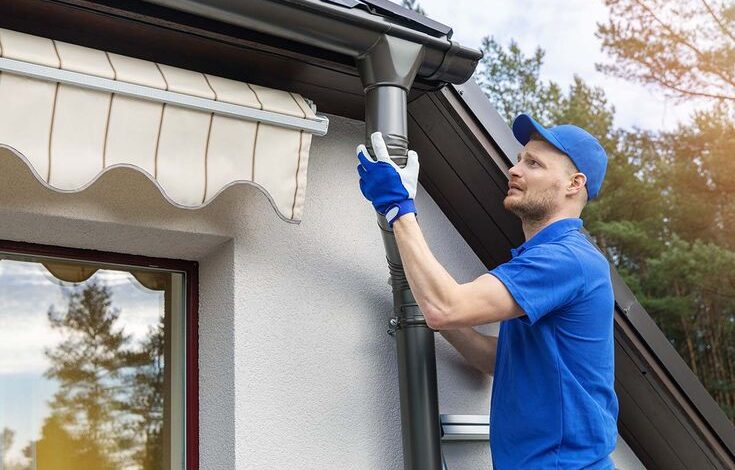Safeguarding Structures: A Complete Guide to Modern Gutter Systems

Homeowners and builders often focus on foundations, walls, and roofing materials when designing or maintaining a house. However, there is one unassuming yet critically important component that often goes unnoticed until it fails: the gutter system. Gutters protect homes and buildings from water damage, and their role in preventing erosion, flooding, and structural degradation cannot be overstated.
In this comprehensive guide, you will discover the vital function gutters serve, the types and materials available, design options, installation best practices, and how to maintain your system for long-term performance. Whether you’re installing a new system or replacing an old one, understanding these fundamentals will help you make informed decisions that protect your investment.
The Function and Importance of Gutters
Rainwater, when not properly managed, can become one of the most destructive forces a home can face. Gutters are responsible for collecting rainwater from the roof and directing it away from the foundation through downspouts and drainage systems. Without gutters, water can flow freely off the edge of the roof, saturating the ground near the foundation, flooding basements, damaging siding, and eroding landscaping.
Key Benefits of a Well-Designed System:
- Foundation Protection: Water pooling near the foundation can lead to cracks, settling, and structural compromise over time.
- Roof Integrity: Proper water drainage reduces the risk of moisture backing up under shingles, which could cause rot and mold.
- Siding and Paint Preservation: Gutters prevent water from running down walls, protecting the exterior from staining, warping, and paint damage.
- Landscape Retention: Controlled water runoff prevents soil erosion and keeps mulch, plants, and pathways intact.
- Pest Deterrence: Standing water near the home can attract mosquitoes and rodents; a good gutter system helps eliminate these risks.
Gutter Materials and Their Characteristics
Gutters come in various materials, each with its own set of advantages and drawbacks. Choosing the right material depends on your climate, budget, aesthetic preferences, and maintenance tolerance.
Aluminum
Aluminum is the most widely used material due to its affordability, light weight, rust resistance, and ease of installation. It can be painted to match any exterior and typically lasts 20 to 30 years.
Vinyl
Vinyl gutters are cost-effective and easy to install, making them popular for DIY projects. They don’t rust or corrode but may crack or warp in extreme temperatures, limiting their durability.
Steel
Galvanized steel gutters are sturdy and can handle heavy loads, but they are prone to rust if not properly treated. Stainless steel is rust-resistant but comes at a higher cost.
Copper
Copper is often chosen for its high-end appearance and longevity. Over time, it develops a natural patina that many homeowners find visually appealing. It’s extremely durable but also one of the most expensive options.
Zinc
Zinc gutters offer a similar aesthetic to copper but are slightly less costly. They are resistant to corrosion and last for decades, but they require professional installation.
Gutter Profiles and Styles
In addition to material selection, homeowners must choose from various gutter profiles that affect both performance and curb appeal.
K-Style
The most common residential gutter type, K-style gutters, have a flat back and a decorative front that mimics crown molding. Their angular shape allows them to hold more water than other profiles, making them ideal for areas that experience heavy rainfall.
Half-Round
With a smooth, rounded shape, half-round gutters offer a traditional look often found on older homes. While aesthetically pleasing, they hold less water and are more prone to clogging.
Box
Box gutters are deeper and wider than typical residential styles. Commonly used on commercial buildings or larger residences, they are designed to handle high volumes of water and are often custom fabricated.
System Design and Component Overview
An effective gutter system includes more than just the horizontal channels attached to the roofline. Here are the key components:
- Gutters: Channels that collect and carry water.
- Downspouts: Vertical pipes that transport water from the gutter to the ground.
- End Caps: Seal the ends of the gutters.
- Elbows: Angled connectors that redirect downspouts.
- Splash Blocks or Extenders: Divert water away from the building at the base of downspouts.
- Hangers and Brackets: Support the gutter and secure it to the fascia.
- Miters: Corner pieces that join two sections of gutter.
The efficiency of the entire system depends on proper sizing and placement of each component to manage the maximum potential water flow.
Seamless vs. Sectional Gutters
Another crucial decision involves choosing between seamless and sectional gutters.
Seamless Gutters
Seamless gutters are custom-made to fit the exact dimensions of your roofline using a continuous piece of material. This minimizes joints, reducing the risk of leaks. They are typically made of aluminum and require professional fabrication and installation.
Sectional Gutters
These gutters are sold in pre-cut lengths and joined together during installation. They are more accessible for DIY projects and less costly upfront but may require more frequent maintenance due to potential leaks at the seams.
Installation Considerations
Correct installation is key to ensuring that your system performs reliably. A poorly installed system can cause more problems than having no system at all. Proper gutter installation starts with a plan that considers roof pitch, drainage area, and local weather patterns.
Key Installation Steps:
- Measurement and Planning: Measure the roofline and calculate the drainage capacity needed based on roof size and expected rainfall.
- Proper Pitch: Gutters must be installed with a slight slope—typically 1/4 inch per 10 feet—to ensure water flows toward the downspouts.
- Secure Mounting: Hangers should be spaced no more than 24 to 36 inches apart to support the weight of water and debris.
- Downspout Placement: At least one downspout for every 20 to 30 feet of gutter is recommended to avoid overflow.
- Leak Prevention: All joints should be sealed with high-quality waterproof sealant, and the system should be tested for leaks.
Professional gutter installation offers advantages like custom fitting, proper sealing, and alignment that DIY projects may not achieve. It also reduces the likelihood of early failure or water damage caused by improper slope or support.
Maintenance and Longevity
Routine maintenance ensures your gutters remain efficient and extends their lifespan.
Cleaning
Gutters should be cleaned at least twice per year—once in spring and once in autumn. Remove leaves, twigs, and other debris to prevent clogs. In regions with heavy tree cover, more frequent cleaning may be necessary.
Inspection
Look for signs of wear such as sagging sections, rust spots, disconnected joints, and peeling paint. These issues can lead to leaks, overflow, or total system failure if not addressed early.
Gutter Guards
Installing gutter guards or screens can reduce the amount of debris entering the system, minimizing maintenance and lowering the risk of clogs. While not entirely maintenance-free, they can be a valuable upgrade.
Downspout Extensions
Ensure that water is discharged far from the foundation—at least 3 to 5 feet. Use extenders or splash blocks to prevent soil erosion and reduce the risk of water damage.
Signs It’s Time to Replace
Even with regular maintenance, no system lasts forever. Here are signs that you may need a replacement:
- Persistent leaks or rust
- Gutters pulling away from the house
- Water pooling near the foundation
- Frequent clogs despite regular cleaning
- Visible holes or cracks
If multiple issues occur simultaneously, replacing the entire system may be more cost-effective than making ongoing repairs.
Conclusion
Gutter systems may be simple in concept, but their execution and performance are critical to a building’s long-term health. From protecting foundations and landscaping to preventing mold and moisture intrusion, gutters are a first line of defense against water damage. With a wide variety of materials, styles, and accessories available, homeowners can design a system that suits both functional needs and architectural style.
Whether you’re building a new home, upgrading an outdated system, or performing annual maintenance, investing time and resources into a high-quality gutter setup is a wise choice. Thoughtful planning, routine care, and professional gutter installation in Avon park can help you avoid costly water damage and ensure your home stays safe and dry for years to come.




